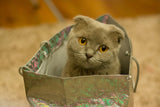Nay-sayers are already likely yelling, "Cats can’t be trained!” Actually, cats are so darn smart that they more often train the human. When Sheba wakes you at 5:15 a.m. on your day off, with purrs, paw-pats and pestering, what do you do? Grumble stumble out of bed--and fill the bowl.
You've been trained by the best!
Accidental Cat Training
To be fair, you've also already trained Sheba to come when called. Yes, you have! Again, think about what happens when the can opener "whirrs" or kibble hits the bowl. The cat comes running, right?
That's because your cat has learned a signal (can opener, rattle in the bowl) that corresponds to something she likes (food) and is rewarded for coming (eating). See, you're a cat trainer and didn't know it!
Simply start using the word come every time you fill the bowl and within a short time your cat will understand what it means. Cats can be trained to come, sit, sit up, wave a paw, and walk on a leash. You can train your cat with clicker training, and her favourite treat. Bribes are legal--don't you expect a payday for work? Cats are no different.
Clicker Training Communicates with Kitty
The key to training is to catch your pet in the act of doing something you like and tell the pet you like it with a reward. Clicker training is one of the fastest, easiest ways to communicate this lesson. The sound of the “click” identifies the behaviour and a special treat rewards the cat for performing well.
Get a Clicker
You can find clickers at pet products stores, but any unique sound can work. For instance, some cats prefer the softer "snick" sound of a ballpoint pen. Your cat might respond to a tongue-click, which means you don't have to hunt for your clicker. That leaves your hands free.
Choose a Special Reward
The reward must be very high value to the cat. If it's something available all the time, why should Kitty care? Find out what floats your cat's boat, and reserve that reward for clicker training only.
For some cats, food treats work well. Cats respond first to smell, and second to taste (they won't taste if it doesn't smell good!), so choose a treat with a pungent aroma. Fishy treats are a hit with some cats. Professional cat trainers for movies use smoked turkey cold cuts. It takes only a tiny taste (about the size of the tip of your little finger) for a treat reward. You don't want to upset nutrition, and you don't want the cat to get so full he doesn't want to train.
Cats may instead prefer a toy or play rewards. A special feather tease, or fetch-ball or catnip muse toy could be the reward incentive that makes your cat want to work. Again, reserve that toy so it only comes out for training, to increase the power and value.
Load the Clicker
For clicker training to work, you must first load the clicker. This explains to the pet that the click sound means something wonderful will happen. Basically, you associate the sound (click) with the reward (treat or toy).
Just sit down with the pet and a saucer full of tiny smelly treats, and begin to CLICK (toss a treat), CLICK (treat) CLICK (treat) as many times as the cat shows interest. If the cat prefers the toy, then you'll CLICK (offer the feather) CLICK (feather) CLICK (feather) and so on.
You’ll soon see the pet look at the treats (or toy) rather than the clicker when it makes the sound. Be aware that cats won't want to train for as long a period as dogs. Kitty may be done after only half a dozen repeats. Several very short training sessions are more beneficial than a single marathon event.
Catch Kitty in the Act
Once your cat understands the click means a reward, identify a behaviour you like. So, for example, sit around watching the new eight-week-old kitten (yes, they can be trained at this age!) until the baby happens to “sit.” And you click the behaviour and hand over a treat.
Baby will look clueless. “What’d I do?” He’ll wander around, and eventually “sit” accidentally again (click-treat!). Be sure that you time the click to the exact moment the cat performs the behaviour--timing is key. By the third time this happens, you’ll see the lightbulb go off. Once that happens, the cat will follow you around the house saying, “Look, Mom, I sat,” hoping to turn you into a treat dispenser.
Training goes beyond the trick aspect, though, and engages the pets’ brains. You can extend training to include accepting a crate, a halter, and leash, rides in the car, and more. Training strengthens the bond between owner and cat because suddenly you are communicating--and the cat realizes he can control the outcome by his actions.
Aren’t you happier when you feel accomplished and smart? Give your cat that gift. He'll love you for it.




